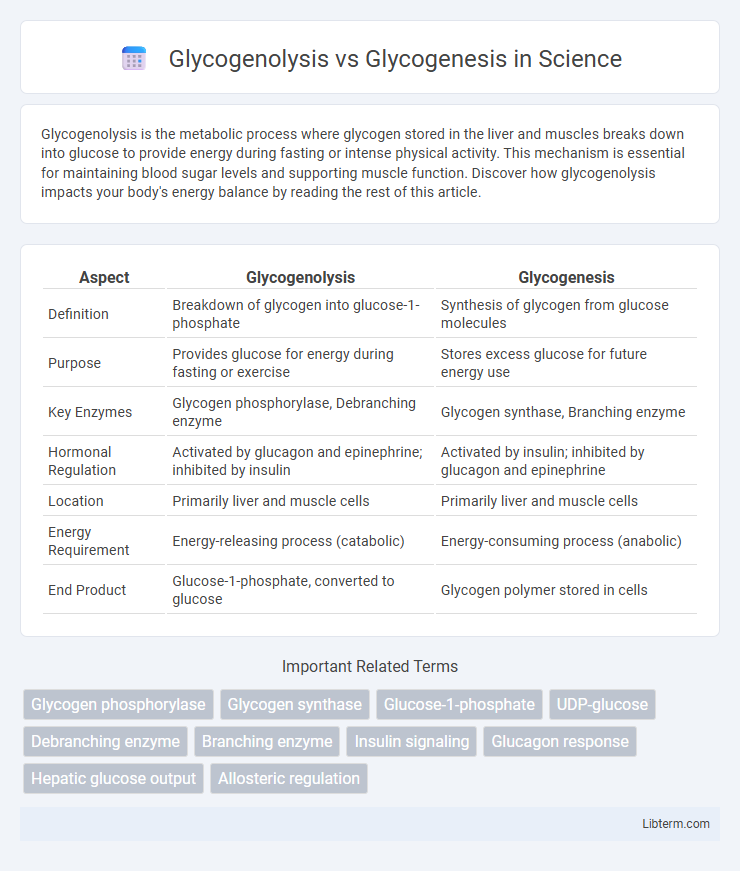Glycogenolysis is the metabolic process where glycogen stored in the liver and muscles breaks down into glucose to provide energy during fasting or intense physical activity. This mechanism is essential for maintaining blood sugar levels and supporting muscle function. Discover how glycogenolysis impacts your body's energy balance by reading the rest of this article.
Table of Comparison
| Aspect | Glycogenolysis | Glycogenesis |
|---|---|---|
| Definition | Breakdown of glycogen into glucose-1-phosphate | Synthesis of glycogen from glucose molecules |
| Purpose | Provides glucose for energy during fasting or exercise | Stores excess glucose for future energy use |
| Key Enzymes | Glycogen phosphorylase, Debranching enzyme | Glycogen synthase, Branching enzyme |
| Hormonal Regulation | Activated by glucagon and epinephrine; inhibited by insulin | Activated by insulin; inhibited by glucagon and epinephrine |
| Location | Primarily liver and muscle cells | Primarily liver and muscle cells |
| Energy Requirement | Energy-releasing process (catabolic) | Energy-consuming process (anabolic) |
| End Product | Glucose-1-phosphate, converted to glucose | Glycogen polymer stored in cells |
Introduction to Glycogen Metabolism
Glycogen metabolism comprises two primary processes: glycogenolysis and glycogenesis, which regulate glucose storage and release in muscle and liver cells. Glycogenolysis breaks down glycogen into glucose-1-phosphate, providing a rapid energy source during fasting or intense physical activity. Glycogenesis synthesizes glycogen from glucose-6-phosphate, facilitating energy storage and maintaining blood glucose homeostasis.
What is Glycogenolysis?
Glycogenolysis is the metabolic process of breaking down glycogen into glucose-1-phosphate, primarily occurring in liver and muscle cells to provide a rapid source of glucose during energy demand. This pathway involves key enzymes like glycogen phosphorylase and debranching enzyme, enabling the mobilization of stored glycogen reserves. Glycogenolysis is crucial for maintaining blood glucose levels and supplying energy during fasting or intense physical activity.
What is Glycogenesis?
Glycogenesis is the biochemical process of synthesizing glycogen from glucose molecules, serving as a mechanism for glucose storage primarily in liver and muscle cells. This process involves key enzymes such as glycogen synthase, which catalyzes the formation of a-1,4-glycosidic bonds, and branching enzyme, which creates a-1,6 branches to produce a highly branched glycogen structure. Glycogenesis plays a crucial role in maintaining blood glucose homeostasis by converting excess glucose into glycogen during times of high energy availability.
Key Enzymes in Glycogenolysis
Glycogenolysis is primarily driven by the enzyme glycogen phosphorylase, which catalyzes the breakdown of glycogen into glucose-1-phosphate by cleaving a-1,4-glycosidic bonds. Debranching enzyme further assists this process by remodeling glycogen to expose additional sites for phosphorylase activity, specifically targeting a-1,6-glycosidic bonds at branch points. In contrast, glycogenesis involves glycogen synthase, which facilitates the addition of glucose units to the growing glycogen chain via a-1,4-glycosidic linkages.
Key Enzymes in Glycogenesis
Glycogenesis is the metabolic process of synthesizing glycogen from glucose, primarily regulated by the enzyme glycogen synthase, which facilitates the addition of glucose units via a-1,4-glycosidic bonds. Another crucial enzyme is branching enzyme (amylo-a(1,4)-a(1,6)-transglucosidase), which introduces a-1,6-linked branch points to increase glycogen solubility and accessibility. In contrast, glycogenolysis involves glycogen phosphorylase and debranching enzyme to break down glycogen into glucose-1-phosphate units for energy release.
Regulatory Mechanisms: Glycogenolysis vs Glycogenesis
Glycogenolysis is regulated primarily by hormones such as glucagon and epinephrine, which activate phosphorylase kinase through cAMP-dependent protein kinase, leading to glycogen breakdown. Glycogenesis is controlled by insulin signaling, which activates protein phosphatase 1 (PP1), promoting glycogen synthase activity for glycogen synthesis. The reciprocal regulation of glycogen phosphorylase and glycogen synthase ensures precise control of glucose homeostasis by switching between glycogenolysis and glycogenesis in response to cellular energy demands.
Hormonal Control and Signal Pathways
Glycogenolysis is primarily stimulated by hormones such as glucagon and epinephrine, which activate the cAMP-dependent protein kinase A (PKA) signaling pathway, leading to the phosphorylation and activation of glycogen phosphorylase. Conversely, glycogenesis is promoted by insulin through the activation of the PI3K/Akt pathway, resulting in the dephosphorylation and activation of glycogen synthase. These hormonal controls and signal transduction mechanisms ensure precise regulation of glucose storage and release in response to metabolic demands.
Physiological Roles and Importance
Glycogenolysis plays a critical role in maintaining blood glucose levels during fasting or intense physical activity by breaking down glycogen into glucose-1-phosphate, which enters glycolysis or is converted to glucose for energy. Glycogenesis is essential for energy storage, converting excess glucose into glycogen primarily in liver and muscle cells, enabling quick mobilization during energy demand. Both processes are tightly regulated by hormonal signals such as insulin and glucagon to ensure metabolic balance and prevent hypoglycemia or hyperglycemia.
Clinical Implications and Disorders
Glycogenolysis and glycogenesis play critical roles in maintaining blood glucose homeostasis, with dysregulation leading to metabolic disorders such as glycogen storage diseases (GSDs). Impaired glycogenolysis can cause hypoglycemia and muscle weakness, as seen in GSD type V (McArdle disease), while defects in glycogenesis contribute to abnormal glycogen accumulation, resulting in hepatomegaly and liver dysfunction characteristic of GSD type I (Von Gierke disease). Understanding the molecular pathways of these processes aids in diagnosing and managing conditions like diabetes mellitus, where glycogen metabolism is often altered.
Summary: Comparing Glycogenolysis and Glycogenesis
Glycogenolysis is the metabolic pathway that breaks down glycogen into glucose-1-phosphate, providing energy during fasting or intense exercise, while glycogenesis is the process of synthesizing glycogen from glucose for energy storage. Key enzymes include glycogen phosphorylase for glycogenolysis and glycogen synthase for glycogenesis, regulated by hormonal signals like glucagon and insulin, respectively. These opposing processes maintain blood glucose homeostasis by balancing glucose availability and storage in liver and muscle tissues.
Glycogenolysis Infographic

 libterm.com
libterm.com